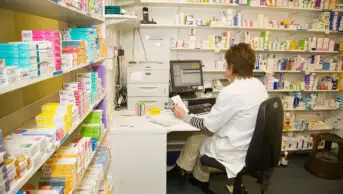
Wes Mountain/The Pharmaceutical Journal
When training to become a pharmacy technician, there are various approaches that can be taken when delivering a successful, competence-based qualification. The usual route through the ‘BTEC Level 3 Diploma in the Principles and Practice for Pharmacy Technicians (Integrated Apprenticeship)’ involves mostly being based in a dispensary and on the ward.
Within the pharmacy department at University Hospitals Plymouth, preregistration trainee pharmacy technicians (PTPT) normally rotate through various roles over two years, gaining skills in dispensary, distribution, aseptic services, quality control, procurement and ward-based services. No previous PTPTs had been solely based within the aseptic unit — until recently.
Our now-pharmacy technician, Richard Cowan, was an assistant technical officer within the aseptic unit prior to successfully obtaining his place on the diploma course. He had a strong interest to continue his career in aseptic services so by working collaboratively, his line manager in the aseptic unit and the department’s education and training teams considered the feasibility of him being based at the aseptic unit for the duration of his course.
We selected Bradford College because the skill-based units suited the approach we were taking
However, we needed to provide assurance that the PTPT apprenticeship could be undertaken within the aseptic unit.
To start, we reviewed training providers. We had prior experience of working with different PTPT apprenticeship providers and were familiar with the various course requirements and content. However, we selected Bradford College because the skill-based units suited the approach we were taking.
Following this, we reviewed Bradford College’s course content in detail and matched against job plans in the aseptic unit. This involved deciding if all or any of the course units could be completed when based within aseptic services.
We found that all units could be completed from within the aseptic area, with the only challenges around undertaking medicines reconciliation and supply; checking of other people’s dispensing; and receiving, validating and issuing prescriptions.
Challenges
Gaining experience in medicines reconciliation was a challenge as no patients come directly into contact with the aseptic unit. We overcame this by capitalising on the link between our aseptic unit and cancer services wards. It was agreed that Cowan could join the pharmacists and pharmacy technicians on the cancer services wards.
We also found that there was greater workflow efficiencies from doing this, benefiting both the wards and the aseptic team. The ordering system between the cancer services wards and the aseptic unit is the same, meaning that Cowan could deal with the supply aspects of the apprenticeship, and he didn’t require additional training.
By being on the cancer services ward, Cowan was also able to accuracy check a wide range of drugs not usually seen on the aseptic unit. He also reviewed each patient’s own drugs checks and used his experience to work towards the course objective of having checked 500 items.
Now that we have a training model to follow, we can specifically recruit for PTPTs for aseptic work in the future
Lastly, in order to meet requirements around receiving, validating and issuing prescriptions, Cowan worked in the hospital dispensary and our outpatient pharmacy service, as this target could not be met at the ward level or in the aseptic unit.
Cowan’s work across multiple settings within the hospital led him to be named ‘Apprentice of the month’ for October 2024 and nominated for ‘Apprentice of the year’ in awards held within University Hospitals Plymouth.
Benefits of bespoke training
Running this bespoke training for Cowan has created a number of benefits for the wider aseptic unit. Most notable is staff retention. Cowan has stayed in his area of interest and has had the opportunity to progress his career without leaving the team. For us, this means we did not need to retrain a replacement within the aseptic unit.
Also, now that we have a training model to follow, we can specifically recruit for PTPTs for aseptic work in the future and can sustain this training model going forward.
Ultimately, introducing PTPT training within the aseptic unit and choosing a best-fit training provider — in our case Bradford College — gave us the results that we were looking for. This has created a new opportunity for us to meet the career progression needs of individuals and the workplace needs of the aseptic unit. However, one size may not fit all and other training providers may be suitable for different models.
For further information contact:
Brian Fulton, senior pharmacy technician education and training, University Hospitals Plymouth NHS Trust: brian.fulton@nhs.net
Rebecca Ellis, senior pharmacy technician education and training: rebecca.ellis5@nhs.net
Gemma Lawty, production services senior pharmacy technician for education and training, University Hospitals Plymouth NHS Trust: gemma.lawty@nhs.net


